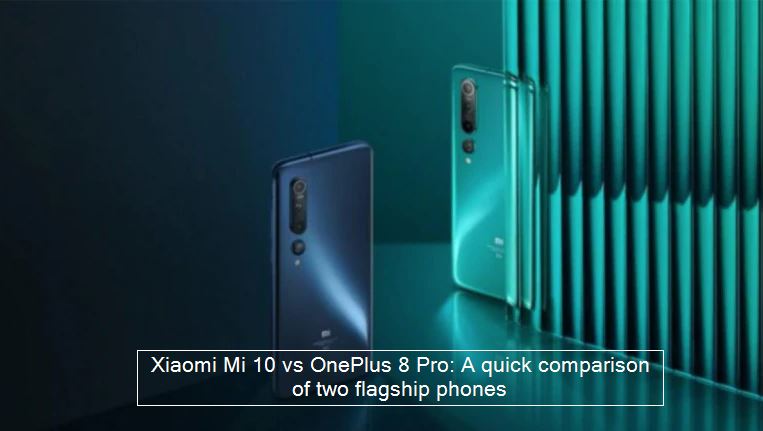Xiaomi Mi 10 vs OnePlus 8 Pro: A quick comparison of two flagship phones
Xiaomi has finally launched the Mi 10 in India, and with starting price of Rs 49,999, it goes up against the likes of the OnePlus 8 and the OnePlus 8 Pro, which were recently launched in India. Here it is compared with the OnePlus 8 Pro.
Xiaomi has launched its much-awaited flagship, the Xiaomi Mi 10. The phone was launched at an online-only event on Friday, which also saw the company unveiling Mi True Wireless Earphones 2, Mi Box 4K and a new wireless charger.
The Mi 10 is Xiaomi’s fresh attempt to make inroads in the premium smartphone segment, which is dominated in India by Apple, OnePlus and Samsung even though Xiaomi is overall the No 1 company in the Indian phone market. Unlike other Xiaomi phones, the Mi 10 is pricier with its price starting at Rs 49,999 and the phone goes up against the likes of the OnePlus 8, OnePlus 8 Pro, iPhone XR, Samsung Galaxy S20 and others.
So how does the Mi 10 compares to the latest from OnePlus which is the OnePlus 8 Pro? Here we take a quick look.
Xiaomi Mi 10 vs OnePlus 8 Pro: Camera
Xiaomi has been long teasing its fans about launching a phone with a 108-megapixel camera on their social media accounts. Even when the Xiaomi launched the Note 9 series, the fans had their eyes only for the phone that has a 108-megapixel camera. Today the moment finally arrived with Xiaomi’s Mi 10 launch. The phone features a 108-megapixel primary camera which consists of a 1/1.33-inch sensor with OIS. The camera island also consists of a 13-megapixel ultra-wide camera with 123-degree FOV, with a 2-megapixel macro sensor and a 2-megapixel depth sensor. On the front, Xiaomi Mi 10 boasts of a 20-megapixel camera with various modes including the Night and Portrait mode. The Mi 10 is the only phone apart from the Samsung Galaxy S20 series to support 8K video recording.
[amazon box=”B07HGJK56Y” “small”]
Coming to OnePlus 8 Pro, on the rear, the smartphone features a 48-megapixel Sony IMX689 primary lens along with another 48-megapixel ultra-wide lens which promises a 120-degree field of view. They are paired with an 8-megapixel telephoto lens and a 5-megapixel color filter lens. On the front, the OnePlus 8 Pro features a Sony IMX471 lens with 16-megapixels image sensor.
On paper, both phones seem to be evenly matched. Xiaomi hasn’t clearly specified if the 108-megapixel camera in the Mi 10 is the same one that is inside the Mi 10 Pro. Because if it is then we know that it is a very capable camera. In DxO ratings, the Mi 10 Pro won praise for its main camera, and if this is the same primary camera in the MI 10 then chances that it could be slightly better than the OnePlus 8 Pro main camera.
But the OnePlus 8 Pro has versatility working in its favour. From all accounts it seems that not only its main camera is fairly good, it also has a very impressive ultra-wide-angle camera. And of course, it has the telephoto lens that Xiaomi Mi 10 lacks.
Xiaomi Mi 10 vs OnePlus 8 Pro: core hardware
The Xiaomi Mi 10 features a 6.67-inch AMOLED display with a resolution of 2340 x 1080. It flaunts curved edges, and its display has a refresh rate of 90Hz. The company has also claimed that the phone has a 180 Hz touch sampling rate.
The OnePlus 8 Pro has a higher resolution 6.78-inch AMOLED screen. The resolution is 1440 x 3168 pixels. It is also a faster display with refresh rate of 120Hz and touch sampling rate of 240Hz. The display has won some awards from DisplayMate and we believe that compared to the display in the Mi 10, OnePlus 8 Pro has a better screen.
[amazon box=”B07DJ8K2KT” “small”]
On the inside, the Xiaomi Mi 10 houses a Qualcomm Snapdragon 865 chipset paired with 8GB of LPDDR5 RAM and up to 256GB of storage. The smartphone comes with support for 5G connectivity. It is same with OnePlus 8 Pro. It too has 8GB RAM and 128GB storage, although OnePlus also offers a 12GB RAM variant paired with 256GB storage.
Under the hood, the Xiaomi Mi 10 houses 4780mAh battery that comes with support for three different types of charging facilities including the 30W fast and 30W wireless charging along with a 10W reverse wireless charging system. Buyers can get the 30W wireless charger in India for Rs 1999 if they pre-order.
In terms of the battery, the OnePlus 8 Pro houses a 4510mAh battery with support for 30W wireless charging. The phone also supports wired Warp 30T charging which OnePlus claims can charge half the battery in just 23 minutes.
In performance and battery, we expect the Mi 10 and OnePlus 8 Pro to be evenly matched if the specs both phones have translated well into the real-world performance. Of course, that depends on software and how well the phones have been optimised. We will take a detailed look at it in the review of these phones in the coming days.
Xiaomi Mi 10 vs OnePlus 8 Pro: Price in India
The Xiaomi Mi 10 was launched in two different variants in India including the 8GB+128 GB and 8GB+ 256 GB variant. It also has a 12GB variant that wasn’t launched in India. The base variant was launched in India Rs 49,999 while the top variant was priced at Rs 54,999. The smartphone is available for pre-order on Xiaomi’s official website.
The 8GB variant of the OnePlus 8 Pro was launched at Rs 54,999. It comes with a storage option of 128GB whereas the top variant of OnePlus 8 Pro with 12GB RAM and 256GB storage is priced at Rs 59,999. The smartphone is available for sale on various e-commerce platforms including the official website of OnePlus.
To sum it up, it is good to see Xiaomi come back to India’s premium phone market with the flagship Mi 10 phone. OnePlus, obviously, is playing in this market for some time. So it has an advantage. The OnePlus 8 Pro also slightly more upmarket with features like IP68 rating and well-polished Oxygen OS software.
Xiaomi, meanwhile, has gone a little aggressive with the price and is entering the market as a challenger. And we know what happens when Xiaomi decides to enter a market. It relentlessly pursues the goal, which is topping the market.
This is what the company has done in the mainstream market with Redmi phones, and up to an extent with Poco phones. In the coming days, we will take a closer look at what the Mi 10 and the OnePlus 8 Pro offer to users in terms of day-to-day smartphone experience.




